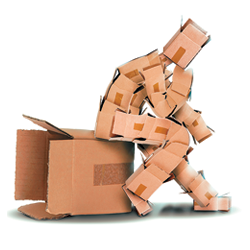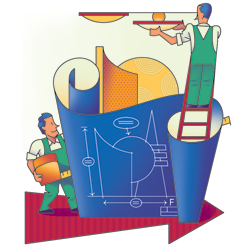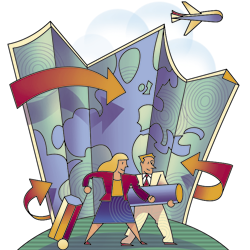
 oing Green is still a hot topic of conversation, but these days, it's the economy, stupid. With some corporations receiving government bailout money while others declare bankruptcy, everyone is watching the bottom line. oing Green is still a hot topic of conversation, but these days, it's the economy, stupid. With some corporations receiving government bailout money while others declare bankruptcy, everyone is watching the bottom line.
Thankfully, there are ways to cut costs in your trade show budget and be kind to the environment at the same time. One of the simplest ways to trim the
fat involves your printed collateral literature.
For years, exhibitors have brought pallets piled with paper to trade shows. However, now is the time to rethink that practice and find a more efficient way to disseminate information. In addition to cutting the production, printing, and shipping costs associated with printed lit, going paper free - or at least reducing the amount of printed lit you ship to shows - helps the environment by reducing both waste and shipping-related carbon emissions.
Here are five examples of exhibit managers who have taken steps toward decreasing paper literature, along with information to help you follow their paper-free lead.
The Proof is in the Paper
With airlines implementing baggage charges for even your first bag, less hard-copy lit is likely to make its way back to your prospects'
offices. Many attendees simply refuse paper or dump it into the closest trash can to avoid lugging it home. Savvy exhibit managers clearly understand this, but convincing internal stakeholders that printed lit no longer makes good business sense can prove tricky.
"Some of them are still stuck in the assumption that attendees come to your booth expecting to receive hard-copy catalogs and product literature. But that assumption is from a previous time when people were more willing to haul that lit home. I don't think people are willing to do that anymore," says Janice Breuer, trade show specialist for biopharmaceutical distributor FFF Enterprises Inc.
All too often, in Breuer's experience, the sales team overestimates the amount of collateral needed at a show. Breuer says she's had entire cases of literature left unopened at the end of the show, which she's then had to pay to ship home.
To help prove her point and put an end to wasted paper lit, Breuer started tracking how much collateral was requested and sent to
each show and how much was returned. For example, when her company exhibited at the American Society of Health-System Pharamacists (SHSP) conference and exhibition, she shipped 200 copies each of an FFF brochure and two product sheets, along with a mix of other printed collateral, such as a magazine and a fact sheet. Then, she tracked how many brochures and copies of the other literature were actually distributed.
According to Breuer, FFF's standard operating procedure recommends sending enough printed lit to accommodate requests from 5 percent of the show's estimated attendance. So if 100,000 attendees are expected to attend a show, FFF sends 5,000 copies of each piece of collateral. But her informal research at SHSP found that a mere 0.06 percent of attendees actually requested the hard-copy brochure.
 By tracking the amount
of literature shipped and
returned at every show,
Breuer has the data to back up her claims and proactively reduce paper waste. She now works with her sales department to identify how much printed collateral
is actually
warranted for each show, by first reviewing how much of it was distributed at the previous year's show. By tracking the amount
of literature shipped and
returned at every show,
Breuer has the data to back up her claims and proactively reduce paper waste. She now works with her sales department to identify how much printed collateral
is actually
warranted for each show, by first reviewing how much of it was distributed at the previous year's show.
"Today, we are better able to estimate how much printed lit we actually need, and avoid overproducing literature that ends up in the trash. As a result, I would say we are sending close to 50 percent less lit to each of the shows we attend."
Paper or Plastic?
Like Breuer, Judy Volker was tired of paying to ship printed literature to trade shows - only to ship most of it home again after the show. And witnessing a transition to digital literature, she believed her company was wasting far too much of its exhibit-marketing budget on printing and shipping lit.
As she prepared for the 2009 Healthcare Information and Management Systems Society conference, Volker, marketing director for health-care software and solutions provider Iatric Systems Inc., decided to give attendees an option as part of a beta test to prove that printed literature was not the only way to distribute information at a trade show.
So instead of just taking paper literature to HIMSS, as was the company's wont in the past, she also brought along a digital alternative. Volker shipped 500 hard copies of literature sheets for each of eight product lines, a total of 4,000 pieces of paper, to the HIMSS show. She also sent 800 CDs, each loaded with all that information.
When attendees requested additional product information and collateral literature, staffers asked whether they wanted the hard-copy lit or one of the CDs pre-loaded with digital lit. By the end of the three-day show, booth staffers had distributed 50 of the paper packets, or 10 percent of what was shipped, along with roughly 400 CDs. In other words, the vast majority of attendees requesting product literature preferred the digital format. "We will, without reservation, be distributing our literature electronically at the next HIMSS show," Volker says.

Volker doesn't see Iatric Systems ever going completely paperless, as there will always be a small handful of clients and prospects who want a tangible, hard-copy fact sheet. But the company's informed evolution to digital literature marks a huge change from printing and shipping thousands of info sheets to sending less than 100 pieces instead.
"We know that switching to CDs from printed sheets saved us around $6,000 for one show, primarily due to decreased printing and shipping costs," Volker says. "Plus, the CD approach offers us the opportunity to include additional information about our corporate capabilities, along with other media, such as flash documents or PowerPoint presentations, making it a much more versatile option."
Bookmark This
Even in the venerable world of book publishing, the presence of digital media is impossible to ignore. That's one reason Moody Publishers decided to take its book catalog to the Internet, rather than printing, shipping, and distributing the bulky hard-copy version at the trade shows it attends.
"The electronic age is taking over," says Steve Gemeiner, director of sales for the Christian publishing company. "We need to be part of that heading to the future." Economics and the environment all came into play when Moody cut the amount of catalogs it sent to BookExpo America by two-thirds, decreasing its total production from nearly 30,000 to 10,000.
To proactively alert customers about the change, Gemeiner mailed a letter to Moody's prospects and pre-registered attendees that addressed the downturned economy and the fact that the company was looking for ways to be more "lean and Green." It explained that instead of requesting a hard-copy catalog, customers could find the latest catalog online.
The letter included a recycled-paper bookmark imbedded with flower seeds that was printed with the URL where the online catalog could be found. Further driving home the company's environmental message, the unique bookmark featured text that read, "Plant the bookmark, plant the word."
The bookmarks also traveled to BookExpo, along with only three cases of paper catalogs for attendees who were unwilling or unable to access the online version. By the end of the show, booth staffers handed out between 300 and 400 bookmarks and only 150 hard-copy catalogs, again proving that attendees are willing to accept - and
in many cases prefer - digital literature.
"Attendees loved the fact that, instead of distributing 30-page catalogs, we were distributing our bookmarks with the URL," Gemeiner says. "They still get access to all the information they need, but they don't have to carry around a heavy catalog all day."
In addition to handing out bookmarks, booth staffers engaged attendees in a discussion regarding the electronic catalog, explaining the environmental and
economic benefits of reducing paper use, as well as the fact that going digital allowed Moody to include more information than it had previously been able to include in the printed version. For example, when customers search the online catalog for a book, the Web page might feature an interview with the writer or links to books on the same subject. And unlike
a printed catalog, the online version can be updated as needed.
Then there are the
financial benefits for Moody. The drayage cost on crates of heavy catalogs is astronomical. Conversely, a box of 1,000 bookmarks fits easily into the overhead compartment of an airplane and can be hand carried onto the show floor. At the recent Christian Booksellers Association show in Denver, the company went from shipping 7 pallets in 2008 to shipping just 3 pallets in 2009, saving hundreds of dollars in drayage costs, thanks to the transition from hard-copy catalogs to the online alternative. Furthermore, the company saw a 50-percent reduction in printing costs.
Stick it to Them
Reducing the amount of paper in its exhibit isn't something new for Cisco Systems Inc. Event marketing
manager Lisa Lawley says
the company started paper-conservation efforts a few years ago, beginning with printing brochures on an as-needed basis. But the four-color print job on heavyweight paper got expensive, and the shipping and drayage costs added up quickly.
About eight years ago, Cisco began offering attendees a digital alternative: business-card sized CDs pre-loaded with all of the information that would have been included in the company's hard-copy brochures. But according to Lawley, the CD option wasn't much better than using paper.
"There is only so much information you can load on a CD," Lawley says. "Plus, the disks were pre-loaded prior to the show with the literature Cisco wanted to distribute, not necessarily the information attendees wanted to read. That is, the CDs were all the same, so if someone wanted one sheet of information, they would have to trudge through the entire CD to find it."
 So in 2007, Cisco went from offering attendees pre-loaded CDs to distributing branded USB drives, which allow visitors to upload only the specific information they want. Booth staffers guide attendees to in-booth Internet-connected computers where they can choose and upload the various pieces of collateral to their Cisco-branded USB drives. So in 2007, Cisco went from offering attendees pre-loaded CDs to distributing branded USB drives, which allow visitors to upload only the specific information they want. Booth staffers guide attendees to in-booth Internet-connected computers where they can choose and upload the various pieces of collateral to their Cisco-branded USB drives.
Not only does Cisco's USB-drive approach facilitate interaction and allow for more personalized service, it also serves as a functional booth giveaway. "As a corporate policy, Cisco doesn't typically distribute
giveaways, unless it's something Green," Lawley says. "But the USB drives are reusable. Since we don't make them read-only, the customers can upload our information, review it, erase it from the drive after they're done, and continue to use it. And since we brand the drives, they have our logo to look at each time they do."
Ask and You Shall Receive
Like Cisco, Honeywell Process Solutions adopted - and later abandoned - a CD-based approach to collateral lit. Because of the company's enormous portfolio, trying to pick the right collateral to take to a trade show is about as scientific as the eeny-meeny-miney-mo method.
Mara Weber, events and users group director for Honeywell, says that in an attempt to cut costs and reduce waste, the company stopped producing printed literature in the third quarter of 2007, and started producing CDs preloaded with literature for each show. But even with the expanded memory available on a CD, it was still impossible to download every piece of the Honeywell portfolio. So when booth visitors requested additional information, staffers swiped the attendees'
badges and sent the materials via e-mail or postal mail after the show. But for the most part, staffers were simply handing out CDs as a catchall, and not capturing attendee information.
Although less paper was being shipped and tossed, there was still waste in the amount of time it took to compile and burn the CDs prior to the show, and create and print the graphics and labels. Evaluating that waste led Weber to re-examine the use of collateral at trade shows altogether.
"This year, we're going paperless and CD-less at our events, and one of the main reasons is ROI," Weber says. Honeywell is still taking some paper to the shows - a customer interest form. The single sheet prompts booth staffers to gather and write down qualifying information and requests for collateral literature, then attach the attendee's business card to the form to simplify post-show contact. Booth staffers classify attendees as qualified leads, and
then mark the attendee's
preferred delivery format (print or e-mail). The material is then sent to the attendees after the show.
"If people ask why we don't have hard-copy lit available in the booth, we spin it a bit as one way of going Green, but also as a way to service our customers'
needs better," Weber says. "This way, they get the information they personally requested, and nothing more to bog them down. Then, when we send them the literature after the show, we copy the accounts manager for follow-up, so he or she knows exactly what the prospect has and has not seen and can tailor follow-up conversations accordingly."
Not only does this translate into better customer relationships and follow-up, Weber says the company has reduced its spending on collateral and CDs at shows by 85 percent.E
|












